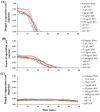Survival of MS2 and Φ6 viruses in droplets as a function of relative humidity, pH, and salt, protein, and surfactant concentrations
- PMID: 33290421
- PMCID: PMC7723248
- DOI: 10.1371/journal.pone.0243505
Survival of MS2 and Φ6 viruses in droplets as a function of relative humidity, pH, and salt, protein, and surfactant concentrations
Abstract
The survival of viruses in droplets is known to depend on droplets' chemical composition, which may vary in respiratory fluid between individuals and over the course of disease. This relationship is also important for understanding the persistence of viruses in droplets generated from wastewater, freshwater, and seawater. We investigated the effects of salt (0, 1, and 35 g/L), protein (0, 100, and 1000 μg/mL), surfactant (0, 1, and 10 μg/mL), and droplet pH (4.0, 7.0, and 10.0) on the viability of viruses in 1-μL droplets pipetted onto polystyrene surfaces and exposed to 20%, 50%, and 80% relative humidity (RH) using a culture-based approach. Results showed that viability of MS2, a non-enveloped virus, was generally higher than that of Φ6, an enveloped virus, in droplets after 1 hour. The chemical composition of droplets greatly influenced virus viability. Specifically, the survival of MS2 was similar in droplets at different pH values, but the viability of Φ6 was significantly reduced in acidic and basic droplets compared to neutral ones. The presence of bovine serum albumin protected both MS2 and Φ6 from inactivation in droplets. The effects of sodium chloride and the surfactant sodium dodecyl sulfate varied by virus type and RH. Meanwhile, RH affected the viability of viruses as shown previously: viability was lowest at intermediate to high RH. The results demonstrate that the viability of viruses is determined by the chemical composition of carrier droplets, especially pH and protein content, and environmental factors. These findings emphasize the importance of understanding the chemical composition of carrier droplets in order to predict the persistence of viruses contained in them.
Conflict of interest statement
No authors have competing interests.
Figures






Similar articles
-
Inactivation of viruses on surfaces by infrared techniques.Int J Therm Sci. 2022 Sep;179:107595. doi: 10.1016/j.ijthermalsci.2022.107595. Epub 2022 Jun 4. Int J Therm Sci. 2022. PMID: 35692600 Free PMC article. Review.
-
Survival of the Enveloped Virus Phi6 in Droplets as a Function of Relative Humidity, Absolute Humidity, and Temperature.Appl Environ Microbiol. 2018 May 31;84(12):e00551-18. doi: 10.1128/AEM.00551-18. Print 2018 Jun 15. Appl Environ Microbiol. 2018. PMID: 29625986 Free PMC article.
-
Transfer Rate of Enveloped and Nonenveloped Viruses between Fingerpads and Surfaces.Appl Environ Microbiol. 2021 Oct 28;87(22):e0121521. doi: 10.1128/AEM.01215-21. Epub 2021 Sep 1. Appl Environ Microbiol. 2021. PMID: 34469200 Free PMC article.
-
Rapid virucidal activity of an air sanitizer against aerosolized MS2 and Phi6 phage surrogates for non-enveloped and enveloped vertebrate viruses, including SARS-CoV-2.Appl Environ Microbiol. 2025 Jan 31;91(1):e0142624. doi: 10.1128/aem.01426-24. Epub 2024 Dec 6. Appl Environ Microbiol. 2025. PMID: 39641606 Free PMC article.
-
Review of factors affecting virus inactivation in aerosols and droplets.J R Soc Interface. 2024 Jun;21(215):18. doi: 10.1098/rsif.2024.0018. Epub 2024 Jun 26. J R Soc Interface. 2024. PMID: 38920060 Free PMC article. Review.
Cited by
-
Higher Concentrations of Bacterial Enveloped Virus Phi6 Can Protect the Virus from Environmental Decay.Appl Environ Microbiol. 2021 Oct 14;87(21):e0137121. doi: 10.1128/AEM.01371-21. Epub 2021 Aug 18. Appl Environ Microbiol. 2021. PMID: 34406830 Free PMC article.
-
RNA Stability: A Review of the Role of Structural Features and Environmental Conditions.Molecules. 2024 Dec 18;29(24):5978. doi: 10.3390/molecules29245978. Molecules. 2024. PMID: 39770066 Free PMC article. Review.
-
Inactivation of viruses on surfaces by infrared techniques.Int J Therm Sci. 2022 Sep;179:107595. doi: 10.1016/j.ijthermalsci.2022.107595. Epub 2022 Jun 4. Int J Therm Sci. 2022. PMID: 35692600 Free PMC article. Review.
-
The microphysics of surrogates of exhaled aerosols from the upper respiratory tract.Aerosol Sci Technol. 2024 Apr 2;58(4):461-474. doi: 10.1080/02786826.2023.2299214. Epub 2024 Jan 17. Aerosol Sci Technol. 2024. PMID: 40236828 Free PMC article.
-
Inactivation of SARS-CoV-2 at acidic pH is driven by partial unfolding of spike.Commun Biol. 2025 Jul 21;8(1):1082. doi: 10.1038/s42003-025-08514-w. Commun Biol. 2025. PMID: 40691508 Free PMC article.
References
-
- World Health Organization Geneva. Global health estimates 2016: deaths by cause, age, sex, by country and by region, 2000–2016. 2018.
Publication types
MeSH terms
Substances
LinkOut - more resources
Full Text Sources

